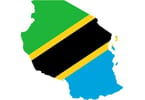There is no widespread tsunami threat in Puerto Rico, different from first reported by some media. However a local threat could be possible. A strong 6.5-magnitude earthquake struck at sea off the Puerto Rican coast at a shallow depth of less than 30 km early on Monday, the US Geological Survey reports.
The quake hit some 56 km off the northern coast of the island. The capital, San Juan, where 400,000 people live is located on the same side of the island.
No immediate injuries or damage has been reported. The tourism industry is extensive on this part of the island. The Pacific Tsunami Warning Center said the quake could trigger a local tsunami, but there is no threat for a widespread tsunami is in place.
The Puerto Rico quake on Monday comes almost exactly 4 years after a powerful 7.0-magnitude quake devastated another Caribbean island – Haiti.
The 2010 disaster took more than 100,000 lives and caused a humanitarian catastrophe in the nation, which remains one of the poorest in the world.
Seismotectonics of the Caribbean Region and Vicinity
ٽيڪٽونڪ راڄن جو وسيع تنوع ۽ پيچيدگي ڪيريبين پليٽ جي پريميٽ کي نمايان ڪري ٿي، جنهن ۾ گهٽ ۾ گهٽ چار وڏيون پليٽون شامل نه هونديون آهن (اتر آمريڪا، ڏکڻ آمريڪا، نازڪا ۽ ڪوڪوس). گہرے زلزلن جا مائل علائقا (Wadati-Benioff zones)، سامونڊي خندق، ۽ آتش فشانن جا آرڪس واضح طور تي سامونڊي لٿوسفيئر جي مرڪزي آمريڪي ۽ ائٽلانٽڪ سمنڊ جي ڪيريبين پليٽ جي مارجن سان گڏ ذيلي ذخيري جي نشاندهي ڪن ٿا، جڏهن ته گوئٽي مالا، وينزمن، اتر ۽ وينزمن ۾ ڪرسٽل زلزلي ريج ۽ ڪيمن خندق ظاهر ڪن ٿا ٽرانسفارم فالٽ ۽ پل-اپارٽ بيسن ٽيڪٽونڪس.
ڪيريبين پليٽ جي اترين مارجن سان گڏ، اتر آمريڪا جي پليٽ اولهه طرف ڪيريبين پليٽ جي حوالي سان لڳ ڀڳ 20 ملي ميٽر في سال جي رفتار سان هلي ٿي. موشن ڪيترن ئي وڏن ٽرانسفارم فالٽ سان گڏ ڪئي وئي آهي جيڪي اوڀر طرف اسلا ڊي روٽان کان هٽي تائين پکڙيل آهن، جن ۾ سوان آئيلينڊ فالٽ ۽ اورينٽي فالٽ شامل آهن. اهي غلطيون ڪيمن خندق جي ڏکڻ ۽ اترين حدن جي نمائندگي ڪن ٿيون. وڌيڪ اوڀر، ڊومينڪن ريپبلڪ کان ٻيٽ آف باربوڊا تائين، اتر آمريڪا جي پليٽ ۽ ڪيريبين پليٽ جي وچ ۾ لاڳاپي واري حرڪت تيزي سان پيچيده ٿيندي وڃي ٿي ۽ جزوي طور تي ڪئريبين پليٽ جي هيٺان اتر آمريڪا جي پليٽ جي لڳ ڀڳ آرڪ-متوازي ذيلي ذخيري سان ٺهڪي اچي ٿي. ان جي نتيجي ۾ گہرے پورٽو ريڪو خندق جي ٺهڻ ۾ ۽ ذيلي سليب جي اندر وچولي مرڪز زلزلي جو هڪ زون (70-300 ڪلوميٽر جي کوٽائي) ۾. جيتوڻيڪ پورٽو ريڪو سبڊڪشن زون سوچيو وڃي ٿو ته هڪ ميگاٿرسٽ زلزلو پيدا ڪرڻ جي قابل آهي، گذريل صديء ۾ اهڙا واقعا نه ٿيا آهن. آخري امڪاني انٽرپليٽ (ٿورسٽ فالٽ) واقعو هتي 2 مئي 1787 تي پيش آيو ۽ سڄي ٻيٽ تي وڏي پئماني تي محسوس ڪيو ويو، دستاويزي تباهي سان سڄي اتر ساحل تي، بشمول آرڪيبو ۽ سان جوآن. 1900 کان وٺي، هن علائقي ۾ اچڻ وارا ٻه وڏا زلزلا هئا 4 آگسٽ 1946 جو M8.0 سمانا جو زلزلو اتر اوڀر هسپانيولا ۾ ۽ 29 جولاءِ 1943 جو M7.6 مونا پاسج زلزلو هو، اهي ٻئي اٿل پٿل فالٽ زلزلا هئا. هن علائقي ۾ اتر آمريڪا جي پليٽ ۽ ڪيريبين پليٽ جي وچ ۾ حرڪت جو هڪ اهم حصو کاٻي پاسي واري اسٽرائڪ سلپ فالٽ جو هڪ سلسلو آهي جيڪو هسپانيولا جي ٻيٽ کي جدا ڪري ٿو، خاص طور تي اتر ۾ Septentrial فالٽ ۽ Enriquillo-Plantain ڏکڻ ۾ باغ جي غلطي. Enriquillo-Plantain گارڊن فالٽ سسٽم جي ڀرسان سرگرمي 12 جنوري 2010 M7.0 هيٽي جي هڙتال واري زلزلي، ان سان لاڳاپيل آفٽر شاڪس ۽ 1770 ۾ آيل زلزلي جي تباهي کان بهترين دستاويز آهي.
اوڀر ۽ ڏکڻ طرف ھلندي، پليٽ بائونڊري وکر پورٽو ريڪو ۽ اترين ليزر اينٽيليس جي چوڌاري جتي اتر ۽ ڏکڻ آمريڪا جي پليٽن جي نسبت سان ڪيريبين پليٽ جو پليٽ موشن ويڪٽر گھٽ تريل آھي، جنھن جي نتيجي ۾ فعال جزائر-آرڪ ٽيڪٽونڪس آھي. هتي اتر ۽ ڏکڻ آمريڪا جون پليٽون 20 ملي ميٽر في سال جي شرح سان ننڍي انٽيليس خندق سان گڏ ڪيريبين پليٽ جي هيٺان اولهه طرف ڪن ٿيون. ھن ذيلي ذخيري جي نتيجي ۾، ھيٺ ڏنل پليٽن جي وچ ۾ وچولي مرڪز وارا زلزلا ۽ ٻيٽ جي آرڪ سان گڏ فعال آتش فشانن جو سلسلو موجود آھي. جيتوڻيڪ Lesser Antilles ڪيريبين ۾ سڀ کان وڌيڪ زلزلي جي لحاظ کان سرگرم علائقن مان هڪ سمجهيو ويندو آهي، انهن مان ڪجھ واقعا گذريل صديء ۾ M7.0 کان وڌيڪ آهن. گواڊيلوپ جو ٻيٽ ھن علائقي ۾ 8 فيبروري 1843ع تي آيل سڀ کان وڏي ميگاٿرسٽ زلزلي جو ماڳ ھو، جنھن جي تجويز ڪيل شدت 8.0 کان وڌيڪ ھئي. 29 نومبر 2007 M7.4 مارٽنيڪ جو زلزلو فورٽ-ڊي-فرانس جي اتر-اولهه ۾ آيل سڀ کان وڏو وچولي-گهرائي وارو زلزلو ننڍي انٽيليس آرڪ سان گڏ اچڻ وارو هو.
The southern Caribbean plate boundary with the South America plate strikes east-west across Trinidad and western Venezuela at a relative rate of approximately 20 mm/yr. This boundary is characterized by major transform faults, including the Central Range Fault and the Boconó-San Sebastian-El Pilar Faults, and shallow seismicity. Since 1900, the largest earthquakes to occur in this region were the October 29, 1900 M7.7 Caracas earthquake, and the July 29, 1967 M6.5 earthquake near this same region. Further to the west, a broad zone of compressive deformation trends southwestward across western Venezuela and central Columbia. The plate boundary is not well defined across northwestern South America, but deformation transitions from being dominated by Caribbean/South America convergence in the east to Nazca/South America convergence in the west. The transition zone between subduction on the eastern and western margins of the Caribbean plate is characterized by diffuse seismicity involving low- to intermediate-magnitude (M<6.0) earthquakes of shallow to intermediate depth. The plate boundary offshore of Colombia is also characterized by convergence, where the Nazca plate subducts beneath South America towards the east at a rate of approximately 65 mm/yr. The January 31, 1906 M8.5 earthquake occurred on the shallowly dipping megathrust interface of this plate boundary segment. Along the western coast of Central America, the Cocos plate subducts towards the east beneath the Caribbean plate at the Middle America Trench. Convergence rates vary between 72-81 mm/yr, decreasing towards the north. This subduction results in relatively high rates of seismicity and a chain of numerous active volcanoes; intermediate-focus earthquakes occur within the subducted Cocos plate to depths of nearly 300 km. Since 1900, there have been many moderately sized intermediate-depth earthquakes in this region, including the September 7, 1915 M7.4 El Salvador and the October 5, 1950 M7.8 Costa Rica events. The boundary between the Cocos and Nazca plates is characterized by a series of north-south trending transform faults and east-west trending spreading centers. The largest and most seismically active of these transform boundaries is the Panama Fracture Zone. The Panama Fracture Zone terminates in the south at the Galapagos rift zone and in the north at the Middle America trench, where it forms part of the Cocos-Nazca-Caribbean triple junction. Earthquakes along the Panama Fracture Zone are generally shallow, low- to intermediate in magnitude (M<7.2) and are characteristically right-lateral strike-slip faulting earthquakes. Since 1900, the largest earthquake to occur along the Panama Fracture Zone was the July 26, 1962 M7.2 earthquake.






















